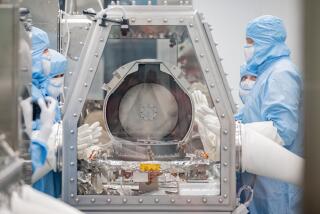Samples From Atlantic Floor Prove Huge Asteroid Hit Earth, Experts Say
- Share via
WASHINGTON — Scientists who drilled core samples from the ocean bed said Sunday they have found proof that a huge asteroid smashed into Earth about 65 million years ago and probably killed off the dinosaurs.
“We’ve got the smoking gun,” said Richard D. Norris, leader of an international expedition that probed the Atlantic Ocean floor in search of asteroid evidence. “It is proof positive of the impact.”
Norris said the expedition recovered three drill samples that have the unmistakable signature of a asteroid impact. The drill cores include a thin brownish section that the scientists called the “fireball layer” because it is thought to contain bits of the asteroid itself.
“These neat layers of sediment bracketing the impact have never been found in the sea before,” Norris said.
The scientists, working on the drill ship Joides Resolution, spent five weeks off the east coast of Florida collecting cores from the ocean floor in about 8,500 feet of water. The team penetrated up to 300 feet beneath the sea bed, drilling past sediments laid down at the time of the dinosaur extinction.
Norris said the deepest layers contain fossil remains of many animals and came from a healthy, “happy-go-lucky ocean” just before the impact.
Just above that is a layer with small green glass pebbles, thought to be ocean-bottom material instantly melted by the massive energy release of the impact.
Next was a rusty brown layer that Norris said is thought to be from the “vaporized remains of the asteroid itself.”
The heat of the impact would have been so intense, Norris said, that the stony asteroid would have instantly been reduced to vapor and thrown high into the sky, some of it perhaps even reaching outer space. It then is thought to have snowed down, like a fine powder, all over the globe. Norris said brown deposits, like that in the core sample, have been found elsewhere and have a high content of iridium, a chemical signature of asteroids.
Just above the brown layer are two inches of gray clay with strong evidence of a nearly dead world.
This dead zone lasted about 5,000 years, the scientist said, and then the core samples showed evidence of renewed life.
“It is amazing how quickly the new species appeared,” he said.
Although the impact occurred in the southern Gulf of Mexico, Norris went to the Atlantic Ocean, near the edge of the continental shelf. He said the violence of the impact, followed by huge waves, roiled the Gulf of Mexico so much that clear core samples are unlikely to be found there.
He said the team theorized that waves from the impact would have washed completely across Florida, depositing debris in the Atlantic. And that’s where he found it.
Robert W. Corell, assistant director for geo-science of the National Science Foundation, said the core samples are the strongest evidence yet that an asteroid impact caused the extinction.
“In my view, this is the most significant discovery in geo-sciences in 20 years,” he said. “This gives us the facts of what happened to life back then. I would certainly call it the smoking gun.”
The ship bearing the core samples returned to port Friday, and the science foundation announced the findings Sunday, coincidentally just hours before NBC-TV was to air a movie about a fictional asteroid hitting Earth and causing widespread destruction.
“The impact of the asteroid featured in tonight’s NBC-TV show is peanuts compared to the real thing faced by the world 65 million years ago,” Corell said.
Geologist Walter Alvarez of UC Berkeley first proposed in 1980 that the dinosaurs disappeared from fossil history suddenly because of a massive asteroid hit. At first, the theory had few supporters.
But in 1989, scientists found evidence of a huge impact crater north of Chicxulub, on Mexico’s Yucatan Peninsula.
It is now widely believed that an asteroid of six to 12 miles in diameter smashed to Earth at thousands of mph, and that it instantly gouged a crater 150 to 180 miles wide.
More to Read
Sign up for Essential California
The most important California stories and recommendations in your inbox every morning.
You may occasionally receive promotional content from the Los Angeles Times.










